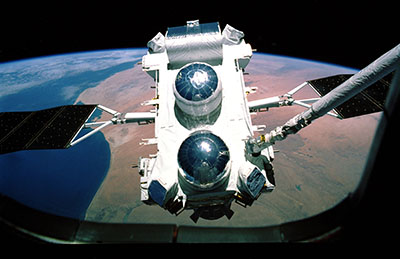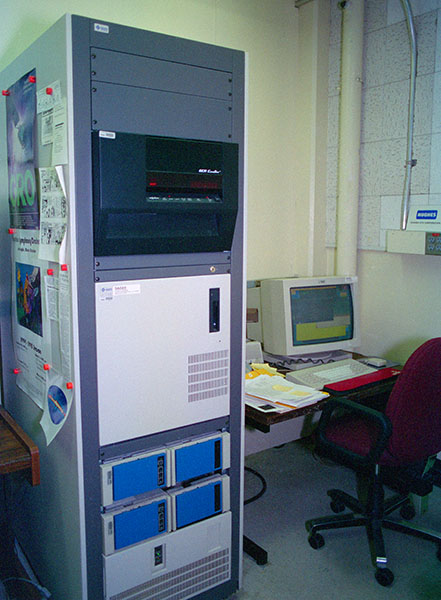David's Bio
David is a system administrator for the Astrophysics Science Division (Code 660) at NASA/GSFC, specializing in Macintosh and UNIX systems (Linux, etc), as well as perl & python scripting and automation, supporting & porting scientific software to new operating systems, designing advanced mail server systems, and more.
David joined GSFC's Laboratory for High Energy Astrophysics (LHEA, Code 660) in 1988 as the Data Manager for the Energetic Gamma Ray Experiment Telescope (EGRET) instrument aboard the Compton Gamma Ray Observatory, one of NASA's Four Great Observatories.
By his starting in the fall of 1988, while EGRET was in thermal vacuum testing at Goddard, he was fortunate to have seen and been involved with the instrument hardware before it was shipped to TRW in California a few months later. It gave that much more of a visceral feeling when he was able to be in Florida to watch CGRO launch aboard the Space Shuttle Atlantis in April 1991.
As Data Manager, David worked with Dr. Dave Thompson to teach a team of eight data analysts how to recognize gamma ray tracks through the EGRET spark chamber, a remarkable manual process whereby the analysts evaluated about a million potential gamma ray events, because the pattern recognition program of the day could only handle about 85% of the data and needed human judgment for the rest (but 50% of the final 'good' gamma ray events came from the analysts' work).
Within months of arriving, the EGRET group purchased their first UNIX workstations (to go along with the local PDP-11/44 and VAX/VMS computers, as well as GSFC IBM MVS and VM mainframes). These first machines were Tektronix workstations, followed soon by Suns, and eventually encompassing a menagerie of six 'flavors' of UNIX: U-Tek 4 and U-Tek V (BSD and AT&T System V Tektronixes, respectively), SunOS, Sun Solaris, IBM AIX, and Silicon Graphics IRIX (all before 1993 or so).
Being the only person in the group who already knew UNIX (having learned BSD UNIX on a IBM 11/750 as an undergraduate and then Sun 3 systems in grad school), David taught UNIX skills to 35 people in the EGRET group, and became the de facto system administrator for the group. In the days when Sun Microsystems shipped a four-foot wide set of binders with printed documentation, David learned a great deal with one binder or another spread across his lap, trying to figure out intricacies of early NFS, NIS/Yellow Pages, and other protocols and sub-systems.
By 1995, David was offered a position (unsolicited) on the LHEA-wide system administration team, as money was starting to ramp down on the EGRET/CGRO missions. He split his time between EGRET and the LHEA System Team for five years until CGRO was deliberately crashed into the Pacific Ocean in June 2000.
As with EGRET, he has thoroughly enjoyed his time in Code 660/LHEA (now the Astrophysics Science Division (ASD), Code 660, since 2004), acting as a Mac evangelist, mentoring younger colleagues, and showing people how the Mac can function as a full-blown UNIX workstation. The latter often involves porting scientific software to the Mac for which running on macOS has never been attempted or the instructions are out of date or wrong.
His various UNIX interests have included setting up advanced mail servers, often implementing features and security years before similar GSFC-wide offerings appeared. These have included POP-before-SMTP to eliminate open mail relays (in 1994), automated tools for maintaining mailing lists, early webmail, IMAP, SpamAssassin protection, and more.
In conjunction with another Code 660 sysadmin, in 2004 he co-developed the first secure wide-ranging wireless network at Goddard, used by 300 people in 5 buildings using a RADIUS server and per-user SSL certificates. This ran for several years until the Goddard networking group set up their own system Center-wide.
David comes to a scientific computing realm with a background in both areas, with graduate degrees in Physics & Astronomy and Computer Science, both from Johns Hopkins University, following an undergraduate career as a Physics and History double-major at Washington University in St. Louis. And David's interest in astronomy comes, at least initially, by way of his father, Michael W. Friedlander, an Emeritus Professor of Physics and Astronomy at Wash. U., with research interests in cosmic-rays, infrared astronomy, archeoastronomy, and science-and-society issues.
April 2020
Photo credits:
Compton GRO: photo © by NASA (Space Shuttle Astronauts);
EGRET Data Area photo © NASA/GSFC photographer (unknown);
EGRET instrument photo and Sun computer rack photo © by David.





